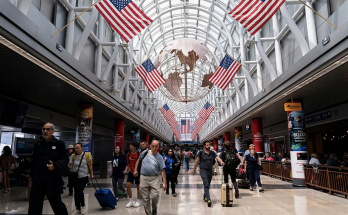
With global safety concerns on the rise, the government has issued an updated travel advisory, urging travelers to stay informed and prepared.
The U.S. Department of State has updated its highest-level travel advisory, adding North Korea (NK) to its “Level 4: Do Not Travel” list. The update, issued on April 29, 2025, brings the total number of countries under the most severe warning to 21.

Travelers arrive at San Francisco International Airport on April 24, 2025. | Source: Getty Images
The advisory warns, “Do not travel to the Democratic People’s Republic of Korea for any reason,” citing the ongoing risk of “arrest, long-term detention, and the threat of wrongful detention of U.S. nationals.”
U.S. passports are not valid for travel to NK unless specially authorized by the Secretary of State — exceptions that are granted “only in very limited circumstances.”

People pay tribute to Kim Il Sung and Kim Jong Il’s statues in Pyongyang on April 15, 2025, for Kim Il Sung’s 113th birthday. | Source: Getty Images
In addition to legal restrictions, the U.S. government cannot directly assist its citizens in NK due to the absence of diplomatic relations. Sweden serves as the U.S. protecting power in Pyongyang, but is often denied access to detained Americans. “The U.S. government cannot guarantee your release,” the advisory notes.

People walk by a poster in Pyongyang on February 16, 2025, marking Kim Jong Il’s 83rd birthday | Source: Getty Images
Travelers who receive special authorization are urged to have contingency plans in place and “draft a will and designate appropriate insurance beneficiaries.” The state also emphasized that the Centers for Disease Control and Prevention (CDC) website provides the latest Travel Health Information for travelers going to and from the United States.

Passengers check in for an American Airlines flight at San Francisco International Airport on April 24, 2025 | Source: Getty Images
NK’s inclusion reflects broader risks that guide Level 4 travel designations. These advisories apply to countries where threats to personal safety are extreme, often due to armed conflict, terrorism, civil unrest, or weak infrastructure.
The department explains that it aims to “clearly explain the reason for the Travel Advisory level and describe the safety and security concerns.” U.S. citizens are strongly urged to avoid travel to these destinations and to take precautions if already present.

An airline employee pass luggage to passengers at a baggage carousel at Hollywood Burbank Airport on December 27, 2022 | Source: Getty Images
With NK now included, the Level 4 list spans 21 countries. It also includes Burkina Faso, Yemen, Iran, South Sudan, Syria, the Democratic Republic of the Congo, Afghanistan, Lebanon, the Central African Republic, Belarus, Iraq, Ukraine, Venezuela, Haiti, Libya, Somalia, Russia, Burma (Myanmar), Mali, and Sudan.
This growing list reflects shifting global risk conditions and underscores the importance of careful travel planning. The four-tier system, ranging from Level 1 to Level 4, is regularly reviewed and revised based on evolving security, health, and political factors.
Beyond its highest warnings, the State Department has elevated 10 countries to its “Level 3: Reconsider Travel” advisory in 2025. These include Papua New Guinea, Burundi, Uganda, Bangladesh, Colombia, Guinea-Bissau, Trinidad and Tobago, Niger, Chad, and Pakistan.
Each update addresses heightened risks ranging from terrorism to violent crime and political unrest.
For Uganda, the advisory, updated on April 23, highlights concerns over crime, terrorism, and laws targeting individuals based on sexual orientation. It also urges travelers to reconsider visiting due to heightened political tensions ahead of the 2026 national elections, which may trigger unplanned and escalating demonstrations.
The advisory also warns, “There remains a threat of terrorist attacks in Uganda,” citing incidents at religious sites, transportation hubs, and tourist areas. In 2023, ISIS-Central Africa carried out an attack in Queen Elizabeth National Park, killing two international tourists and a Ugandan driver.
In addition to the threat of terrorism, violent crime — including armed robbery and sexual assault — remains a persistent concern, particularly in cities like Kampala, Jinja, and Entebbe, where law enforcement often struggles to respond effectively.

Flooded fields are seen after heavy rains in Kampala, Uganda, on March 26, 2025 | Source: Getty Images
Adding to these dangers is the 2023 Anti-Homosexuality Act, which has escalated risks for individuals perceived to be LGBTQ+. “Assault and harassment cases linked to support for lesbian, gay, and bisexual persons have happened across the country,” the advisory notes.
Travelers are advised to avoid demonstrations and large crowds, as these can quickly become dangerous. They should keep a low profile, avoid drawing attention to themselves, and stay aware of their surroundings, particularly in busy tourist areas. Displaying wealth, such as wearing expensive jewelry or using smartphones, should be avoided.
Caution is also advised when walking or driving at night. Travelers are urged not to resist if confronted by robbers and to refrain from opening their hotel or residence doors to strangers unless their identity is confirmed.

Police officers oversee a crowd gathered at a bus terminal in Kampala, Uganda, on October 26, 2021 | Source: Getty Images
Visitors should also stay alert when visiting banks or ATMs, as these locations can be targets for criminals. Enrolling in the Smart Traveler Enrollment Program (STEP) is recommended, as it allows the U.S. government to contact travelers in emergencies and provides important updates.
Given the risks, travelers are urged to review Uganda’s Country Security Report for the latest information and prepare an emergency plan.
Meanwhile, Mexico continues to face serious security concerns, prompting the U.S. Department of State to maintain a state-by-state travel advisory rather than applying a single national risk level.
The latest update, issued on September 6, 2024, includes changes for Chiapas and Durango and reinforces longstanding warnings about violent crime. According to the advisory, “violent crime – such as homicide, kidnapping, carjacking, and robbery – is widespread and common” in many parts of the country.
Six states — Colima, Guerrero, Michoacán, Sinaloa, Tamaulipas, and Zacatecas — are under “Do Not Travel” guidance, the highest level. These areas experience persistent cartel activity, targeted killings, and frequent armed confrontations that pose significant risks to travelers.
Several other states, including Jalisco, Guanajuato, Sonora, and Chihuahua, are classified under “Reconsider Travel.” These regions have also seen elevated violence, particularly in the form of territorial disputes between organized crime groups.
Shootings in public places, attacks on law enforcement, and kidnappings have occurred even in areas frequented by tourists.
The advisory outlines enhanced security measures for U.S. government employees, who are restricted from intercity travel at night, must avoid hailing taxis on the street, and are required to use pre-arranged or app-based transportation. In certain areas, travel is limited to specific highways and only during daylight hours.
These protocols reflect the limited availability of emergency services in rural and high-risk regions.

Vehicles exit the U.S. and enter Mexico at the San Ysidro Port of Entry between San Diego and Tijuana on April 24, 2025 | Source: Getty Images
While threats remain severe in many parts of Mexico, not all states carry high-level warnings. Campeche and Yucatán are listed under “Exercise Normal Precautions,” indicating a lower risk level. Nonetheless, travelers are advised to remain cautious, especially when moving outside urban areas.

Visitors take photos in front of city name letters in San Francisco de Campeche, Mexico, on March 16, 2022 | Source: Getty Images
The State Department emphasizes the importance of reviewing individual state advisories when planning travel to Mexico. Risk levels vary widely across the country, and conditions can change rapidly based on security developments.
Officials continue to urge travelers to stay informed and consult the latest government alerts before visiting destinations where emergency assistance may be restricted or unavailable.


